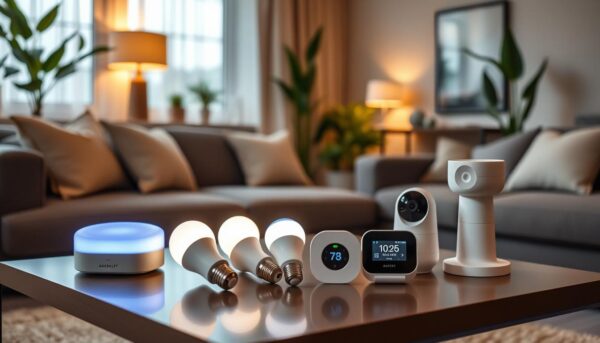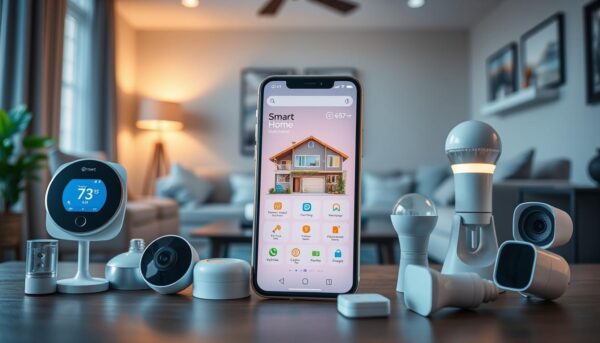✅ Last checked on
Are you ready to turn your home into a smart one? Setting up a smart home hub might seem hard, but it’s easy with the right help. You can control lights, thermostats, security cameras, and doorbells with your voice or a tap on your phone. We’ll show you how to set up your smart home hub and enjoy your connected devices.
We’ll cover the basics of smart home systems like Google Home, Amazon Alexa, and Apple HomeKit. We’ll also talk about the importance of Wi-Fi and Bluetooth for your devices. This will make setting up your smart home hub and integrating your home automation system simple.
Key Takeaways
- Setting up a smart home hub is the first step in creating a smart home ecosystem
- Choosing the right smart home hub, such as Amazon Echo or Google Home, is crucial for seamless smart home hub setup and home automation system integration
- Understanding the basics of smart home ecosystems, including Google Home, Amazon Alexa, and Apple HomeKit, is essential for easy smart hub installation
- Ensuring reliable Wi-Fi and Bluetooth connections is vital for smart home devices to operate effectively, making smart home hub setup and smart home system integration easy
- Smart home hubs, such as Samsung SmartThings or Apple HomePods, can integrate multiple devices, making it easy to control your smart home with a single interface, and making smart home hub installation and home automation system integration easy and straightforward
- Smart home devices, such as smart plugs and smart bulbs, can be easily integrated into your smart home ecosystem, making it easy to control and monitor your home, and making smart home hub setup and smart home system integration easy
- Smart home hub setup and home automation system integration can be done easily with the right guidance and support, making it easy to get the most out of your connected devices and enjoy the benefits of a smart home
Understanding Smart Home Hub Basics
A smart hub is the heart of a smart home, connecting and controlling all devices. It’s key for setting up a smart home. With voice control, managing your devices becomes easy.
The smart home hub is like the brain of your system. It lets you control and watch all devices from one spot. Brands like Samsung’s SmartThings and Apple’s HomeKit are popular. When picking a hub, look at compatibility, network quality, and voice control.
Devices like thermostats, locks, and cameras can be controlled with a smart hub. You can use voice commands to manage them. For instance, you can turn on lights, adjust the thermostat, or lock doors with voice control.
- Device compatibility: Ensure the hub is compatible with your smart home devices
- Network optimization: Choose a hub with robust network optimization for seamless connectivity
- Voice control: Opt for a hub with voice control capabilities for easy management
| Smart Home Hub | Compatibility | Voice Control |
|---|---|---|
| Samsung SmartThings | Over 100 devices | Yes |
| Apple HomeKit | Over 50 devices | Yes |
Essential Prerequisites for Your Smart Home Setup
Before you start with smart home tech, you need to know a few basics. This includes learning about setting up devices and apps. A smart home hub can manage up to 128 devices, making it key to your setup. You’ll also need a strong Wi-Fi network and routers placed well to avoid dead spots.
When setting up, check if your devices work with your hub. Some devices only work with certain hubs, like Amazon Echo or Google Home. For more info on setting up your network, visit smart home network guides.

To set up your smart home app smoothly, follow the manufacturer’s guide. This means setting a strong password, using two-factor authentication, and keeping software updated. These steps help you enjoy smart home tech safely and effectively. Look for features like data encryption and backup batteries in your hub.
Popular devices to add to your hub include smart thermostats, doorbells, and lights. They can save energy, boost security, and make your life better. By learning about device setup and app configuration, you can create a smart home that fits your needs.
Complete Smart Home Hub Setup Process
To set up your smart home hub, start by choosing the right spot. It should be central and close to your devices. This ensures everything works well together.
Next, connect your hub to power and the internet. Make sure the connection is strong to avoid any problems. For more help, check out home automation installation guides.
Configuring your devices is key for a smooth smart home experience. Use features like grouping and scene creation to make your home smarter. With more devices coming out, it’s important to think about compatibility and network setup.
By following these steps, you can make your smart home system efficient and connected. Remember to focus on compatibility and network setup for the best results.
Installing Your Smart Home Mobile App
To enjoy your smart home system fully, you need a smart home app. The setup is easy and takes just a few steps. You can get the SmartThings app from the Play Store or App Store, depending on your device. This app lets you control and watch your smart devices from anywhere.
After downloading the app, follow the steps to set it up. This might include making an account, linking your hub to Wi-Fi, and setting up your devices. For more details, check the Aeotec support page or learn about IoT home networking.
Popular smart home devices like thermostats, locks, and security cameras can be controlled with a mobile app. These devices make your home smarter and more convenient. For instance, you can change your home’s temperature with the Nest Learning Thermostat or lock and unlock doors with the Nest x Yale Lock.

By installing a smart home app and setting up your connected home technology, you get a better living experience. You can control your devices from anywhere, get alerts, and even automate tasks. With the right app, your smart home system can offer you a more connected and comfortable space.
| Device | Features | Benefits |
|---|---|---|
| Nest Learning Thermostat | Energy-saving features, remote control | Convenience, energy efficiency |
| Nest x Yale Lock | Remote locking and unlocking, notifications | Security, convenience |
Connecting and Integrating Smart Devices
To connect your smart devices, you need to think about how they work together. This means pairing them using Bluetooth or Wi-Fi. Then, you group them by room for easier control.
For instance, the Google Home app lets you control other smart devices remotely. With Matter-enabled devices, you can set them up in the Google Home app or through the maker’s app. Matter also has a Multi-Admin feature.
Device Pairing Methods
There are a few ways to pair devices:
- Bluetooth pairing: This method connects devices using Bluetooth technology.
- Wi-Fi pairing: This method connects devices using your Wi-Fi network.
Grouping Devices by Room
Grouping devices by room makes controlling them easier. Each device can only be in one room. But, you can give them nicknames for easier recognition.
By focusing on device configuration and compatibility, you can make your smart home work smoothly. With the right setup, you can control your devices with voice commands, mobile apps, or traditional remotes.
| Device Type | Control Method |
|---|---|
| Smart Lighting | Voice command, mobile app |
| Smart Thermostat | Voice command, mobile app, traditional remote control |
Voice Assistant Integration and Controls
Setting up your smart home means adding voice control devices for a smooth experience. Over 50,000 smart home devices work with the Google Home app. This lets you control TVs, lights, and more with just your voice.
First, make sure your speaker or display is linked to the Google Home app. Then, you can start controlling your smart devices with voice commands.
With voice commands, you can set up routines for different tasks. For instance, a “good morning” routine can turn on lights, adjust the thermostat, and play music. You can start these routines with a voice command, through the Google Home app, or when you walk into the room.
To get the most out of your smart home, rename devices to avoid confusion. Also, keep your speaker or display powered and on the same Wi-Fi as your devices. Voice control makes managing your home easy and hands-free. As the smart home market grows, exploring voice control is exciting.
| Smart Home Device | Compatibility with Voice Assistants |
|---|---|
| Thermostats | Yes, with Amazon Alexa and Google Assistant |
| Security Cameras | Yes, with Amazon Alexa and Google Assistant |
| Light Bulbs | Yes, with Amazon Alexa and Google Assistant |
Adding voice control devices to your smart home makes life easier and more automated. You can control many devices with your voice, saving time and energy. This way, you get the most out of your smart home setup.
Troubleshooting Common Setup Issues
Setting up your smart home hub can sometimes be tricky. You might face connection problems, device issues, or app challenges. It’s key to know how to fix these to enjoy your smart home without stress. Making sure your network is optimized and devices are compatible is crucial.
Common issues include connection problems. These can be fixed by checking your internet and making sure devices are paired right. Device issues can be solved by checking if your devices work with your hub. App problems can be fixed by updating the app or restarting your hub.
To improve your smart home network, consider a multi-protocol hub. It works with Zigbee, Z-Wave, and Thread. This boosts device compatibility and prevents problems. Also, a Thread Border Router can make your network more reliable and extend device range.
- Check your internet connection to resolve connection problems
- Ensure device compatibility with your smart home hub
- Update your app or restart your smart home hub to resolve app-related challenges
By following these tips and optimizing your network, you’ll have a great smart home experience. Always check device compatibility and use a multi-protocol hub to avoid issues.
Conclusion: Making the Most of Your Smart Home System
Setting up a smart home hub is just the start. By optimizing your smart home network and configuring your devices well, you can make your home more efficient and secure. You can automate lights, control the climate, and even use voice commands.
Smart home tech keeps getting better, so keep up with new features. With the right setup and care, your smart home can save you money, increase your home’s value, and make life easier. Enjoy the benefits of a connected home for a better, more convenient life.